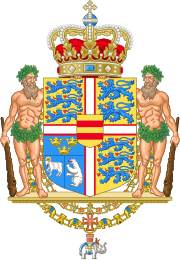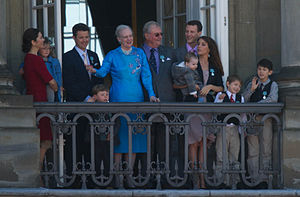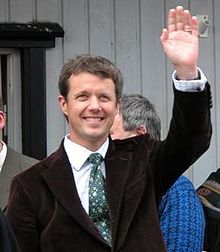Monarchy of Denmark
- This article is about the history and function of the Danish monarchy as an institution. For the kingdom of Denmark itself, see Denmark.
This article needs additional citations for verification. (December 2008) |
| Queen of Denmark | |
|---|---|
| Danmarks Dronning | |
 | |
| Incumbent | |
 | |
| Margrethe II since 14 January 1972 | |
| Details | |
| Style | Her Majesty |
| Heir apparent | Frederik, Crown Prince of Denmark |
| First monarch | Ongendus (according to legend) Gorm the Old (attested) |
| Formation | c. 935 |
| Residence | Amalienborg Palace |
| Website | The Danish Monarchy |
 |
|---|
The monarchy in Denmark is the constitutional monarchy of the Kingdom of Denmark, which includes Denmark, Greenland and the Faroe Islands.
As a constitutional monarch, the Queen is limited to non-partisan, ceremonial functions. The ultimate executive authority over the government of Denmark is still by and through the monarch's royal reserve powers; in practice these powers are only used according to laws enacted in Parliament or within the constraints of convention.
The Danish Royal Family can trace their lineage back to the Viking kings Gorm the Old and Harald Bluetooth from the 10th century, making the monarchy of Denmark the oldest in Europe.[citation needed] The current Royal House is a branch of the princely family of Glücksburg, originally from Schleswig-Holstein in Germany, the same royal house as the Norwegian and former Greek royal families.
Constitutional role
According to the Danish Constitution the Danish Monarch, as head of state, is the source of executive and, cojointly with the Folketing or Parliament, legislative power.[1] The Monarch retains the ability to deny giving a bill royal assent as well as choosing and dismissing the Prime Minister, although in modern times this becomes increasingly more unlikely, as it would cause a constitutional crisis. As Head of State, the monarch participates in the formation of a new government. Bills are required to be countersigned by one or more cabinet ministers to become law (Constitution, III,14) King Christian X was the last Monarch to exercise the power of dismissal on his own will, which he did on March 28, 1920 sparking the 1920 Easter Crisis. All royal powers called Royal Prerogative, such as patronage to appoint ministers and the ability to declare war and make peace, are exercised by the Prime Minister and the Cabinet, with the formal consent of the Queen. After consultation with representatives of the political parties, the Party Leader who has the support of the largest number of seats in the Danish Parliament is invited to form a government. Once it has been formed, the monarch will formally appoint it.[2]
Today the Monarch has an essentially ceremonial role restricted in exercise of power by convention and public opinion. As a figurehead the monarch opens exhibitions, attends anniversaries, inaugurates bridges etc. However the monarch does continue to exercise three essential rights: the right to be consulted, the right to advise and the right to warn. As a consequence of these ideals, the Prime Minister and Cabinet attends the regular meeting of the Council of State. The Prime Minister and the Minister of Foreign Affairs report regularly to the Queen to advise her of the latest political developments. The Queen hosts official visits by foreign Heads of State and pays State Visits abroad.
History
The Danish monarchy is over 1000 years old, making it the fourth oldest continual monarchy in the world still existing today, the oldest being the Imperial House of Japan. The first monarch the monarchy can be traced back to is Gorm the Old (died 958). Originally the monarchy was elective, but in practice the eldest son of the reigning monarch was elected. Later a Coronation Charter was signed by the king to restrict the powers of the Danish monarch. Absolutism was introduced in 1660–1661, when the elective monarchy was transformed into a hereditary monarchy. Male primogeniture succession was laid down in law in the Royal Decree of 1665. On 5 June 1849 the constitution was altered to create a constitutional monarchy for Denmark.[3] The Act of Succession of 27 March 1953 introduced the possibility of female succession, which enabled the current reigning Queen, Margrethe II, to accede the throne.
The last monarch descended from Valdemar IV, Christopher III of Denmark, died in 1448. Count Christian of Oldenburg, descendant of Valdemar IV's aunt Richeza, was chosen as his successor and became the next monarch of Denmark, ruling under the name Christian I. The last Danish monarch of that royal dynasty, Frederik VII, died without issue. In accordance with the act of succession, Prince Christian of Glücksborg acceded the throne, being the first Danish monarch of the house of Glücksborg. Christian eventually became known as 'the Father-in-law of Europe' due to his family ties with most other ruling dynasties of Europe: His daughter Princess Alexandra married Edward VII of the United Kingdom, another daughter Princess Dagmar married Alexander III of Russia and Princess Thyra married Crown Prince Ernst August of Hanover, Duke of Cumberland who was also a British prince. His son Vilhelm went on to become George I of Greece. Further, his grandson Carl became Haakon VII of Norway. To this day the Danish Royal Family are related to most other reigning European dynasties.[3]
Danish Royal Family
In the Kingdom of Denmark all members of the ruling dynasty that hold the title Prince or Princess of Denmark are said to be members of the Danish Royal Family. As with other European monarchies, distinguishing who is a member of the national Royal Family is difficult due to lack of strict legal or formal definition of who is or is not a member. The Queen and her siblings belong to the House of Glücksburg, a branch of the House of Oldenburg. The Queen's children and male-line descendants belong agnatically to the family de Laborde de Monpezat.[4]
Main members

The Danish Royal Family includes:
- The Queen
- The Prince Consort (The Queen's husband)
- The Crown Prince and Crown Princess (The Queen's son and daughter-in-law)
- Prince Christian (The Crown Prince and Crown Princess's son)
- Princess Isabella (The Crown Prince and Crown Princess's daughter)
- Prince Vincent (The Crown Prince and Crown Princess's son born 8 January 2011)
- Princess Josephine (The Crown Prince and Crown Princess's daughter born 8 January 2011)[5][6]
- Prince Joachim and Princess Marie (The Queen's son and daughter-in-law)
- Prince Nikolai (Prince Joachim's elder son)
- Prince Felix (Prince Joachim's middle son)
- Prince Henrik of Denmark (Prince Joachim's and Princess Marie's son together)
- Princess Athena (Prince Joachim's and Princess Marie's daughter together)
- Princess Benedikte (The Queen's sister)
- The Queen of the Hellenes (The Queen's sister)
- Princess Elisabeth (The Queen's first cousin)
Extended members
The extended Danish Royal Family which includes people who do not hold the title of Prince or Princess of Denmark but have close connections to the Queen could be said to include:
- The Prince of Sayn-Wittgenstein-Berleburg (Princess Benedikte's husband)
- The Hereditary Prince of Sayn-Wittgenstein-Berleburg (Princess Benedikte's son)
- Princess Alexandra of Sayn-Wittgenstein-Berleburg (Princess Benedikte's elder daughter)
- Count Jefferson von Pfeil und Klein-Ellguth (Princess Alexandra's husband)
- Count Richard von Pfeil und Klein-Ellguth (Princess Alexandra's son)
- Countess Ingrid von Pfeil und Klein-Ellguth (Princess Alexandra's daughter )
- Princess Nathalie of Sayn-Wittgenstein-Berleburg (Princess Benedikte's younger daughter)
- Alexander Johannsmann, Princess Nathalie's husband
Greek Royal Family
With the exception of Marina, Consort of Prince Michael, and Princesses Alexandra and Olga, all members of the Greek Royal Family are members of the Danish Royal Family and bear the title of Prince or Princess of Greece and Denmark.
- HM King Constantine II of Greece, Prince of Denmark
- Princess Alexia of Greece and Denmark (King Constantine and Queen Anne Marie's daughter)
- Pavlos, Crown Prince of Greece, Prince of Denmark (King Constantine and Queen Anne Marie's son)
- Crown Princess Pavlos of Greece, Princess of Denmark (Prince Pavlos' wife)
- Princess Maria-Olympia of Greece and Denmark (Crown prince and princess's daughter)
- Prince Constantine Alexios of Greece and Denmark (Crown prince and princess's son)
- Prince Achileas-Andreas of Greece and Denmark (Crown prince and princess's son)
- Prince Odysseas-Kimon of Greece and Denmark (Crown prince and princess's son)
- Prince Aristide Stavros of Greece and Denmark (Crown prince and princess's son)
- Prince Nikolaos of Greece and Denmark (King Constantine and Queen Anne Marie's son)
- Princess Tatiana of Greece and Denmark (Prince Nikolaos' wife)
- Princess Theodora of Greece and Denmark (King Constantine and Queen Anne Marie's daughter)
- Prince Philippos of Greece and Denmark (King Constantine and Queen Anne Marie's son)
- Princess Irene of Greece and Denmark (King Constantine's younger sister)
- Prince Michael of Greece and Denmark (King Constantine's cousin)
Succession

Denmark has had absolute primogeniture since 2009. The Danish Act of Succession[7] adopted on 27 March 1953 restricts the throne to those descended from King Christian X and his wife, Alexandrine of Mecklenburg-Schwerin, through approved marriages.
Dynasts lose their right to the throne if they marry without the permission of the monarch given in the Council of State. Individuals born to unmarried dynasts or to former dynasts that married without royal permission, and their descendants, are excluded from the throne. Further, when approving a marriage, the monarch can impose conditions that must be met in order for any resulting offspring to have succession rights. Part II, Section 9 of the Danish Constitution of 5 June 1953 provides that the parliament will elect a king and determine a new line of succession should a situation arise where there are no eligible descendants of King Christian X and Queen Alexandrine.
The monarch of Denmark must be a member of the Danish National Church, or Evangelical Lutheran Church of Denmark (Danish Constitution, II,6). The National Church is by law the State Church, though the monarch is not its head (unlike in England, where the Supreme Governor of the Church of England is the Monarch of the United Kingdom, currently Queen Elizabeth II)(Const, I,4)).[8]
Residences

The royal palaces of Denmark became property of the state with the introduction of the constitutional monarchy in 1849. Since then, a varying number of these has been put at the disposal of the monarchy. The agreement on which is renewed at the accession of every new monarch.
The monarch has the use of the four palaces at Amalienborg in Copenhagen as a residence and work palace. Currently, the Queen herself resides in Christian IX's Palace and the Crown Prince in Frederik VIII's Palace. Christian VIII's Palace has apartments for other members of the royal family, whereas Christian VII's Palace is used for official events and to accommodate guests.
In addition, parts of Christiansborg Palace in Copenhagen is also at the disposal of the monarch. It is the site of official functions such as banquets, state dinners, diplomatic accreditations, public audiences, meetings of the Council of State, receptions, royal christenings, lyings-in-state and other ceremonies. The royal parts of the palace are open to the public when not in use.
Another residence is Fredensborg Palace north of Copenhagen which is used principally in Spring and Autumn. It is often the site of state visits and ceremonial events in the royal family.
In Jutland, Graasten Palace is at the disposal of the monarch. It was used as the summer residence of King Frederick IX and Queen Ingrid. Since the death of Queen Ingrid in 2000, the Queen has stayed at Graasten for a yearly vacation in summer.
The hunting lodge the Eremitage Palace in Dyrehaven north of Copenhagen is used during royal hunts in Dyrehaven.
Finally, Sorgenfri Palace is at the disposal of the monarch. It was the residence of Hereditary Prince Knud and Hereditary Princess Caroline Mathilde and is not in official use at all at this time.
Apart from these state-owned palaces, Marselisborg Palace in Aarhus is privately owned by the Queen. It functions as the summer residence of the Queen, as well as during the Easter and Christmas holidays.
Style

The monarchs of Denmark have a long history of royal and noble titles. Historically Danish monarchs also used the titles 'King of the Wends' and 'King of the Goths'. Upon her accession to the throne in 1972 Queen Margrethe II abandoned all titles except the title 'Queen of Denmark'. The monarch of Denmark and queen-consort are addressed as 'Your Majesty', whereas Princes and Princesses are referred to as His or Her Royal Highness (Hans or Hendes Kongelige Højhed), or His or Her Highness (Hans or Hendes Højhed).
- Eric of Pomerania: By the Grace of God, King of Denmark, Sweden and Norway, the Wends and the Goths, Duke of Pomerania.
- Christopher of Bavaria: By the Grace of God, King of Denmark, Sweden and Norway, the Wends and the Goths, Count Palatine of the Rhine, Duke of Bavaria.
- The full title of the Danish sovereigns from Christian I to Christian II was: By the Grace of God, King of Denmark, Sweden and Norway, the Wends and the Goths, Duke of Schleswig, Holstein, Stormarn and Dithmarschen, Count of Oldenburg and Delmenhorst.
- The full title of the Danish sovereigns from Frederick I to Christian VII was: By the Grace of God, King of Denmark and Norway, the Wends and the Goths, Duke of Schleswig, Holstein, Stormarn and Dithmarschen, Count of Oldenburg and Delmenhorst.
- Oldenburg was elevated to a duchy during the reign of Christian VII, and the style was changed accordingly: By the Grace of God, King of Denmark and Norway, the Wends and the Goths, Duke of Schleswig, Holstein, Stormarn, Dithmarschen and Oldenburg. This style was used until his son, Frederick VI, lost control of Norway by the 1814 Treaty of Kiel.
- Frederick VI gained control over Rügen 1814–1815 leading to the style: By the Grace of God, King of Denmark, the Wends and the Goths, Prince of Rügen, Duke of Schleswig, Holstein, Stormarn, Dithmarschen and Oldenburg.
- In 1815, Frederick VI relinquished Rügen in favour of the Prussian king, and instead gained the Duchy of Lauenburg from the British-Hanoveran king leading to the style: By the Grace of God, King of Denmark, the Wends and the Goths, Duke of Schleswig, Holstein, Stormarn, Dithmarschen, Lauenburg and Oldenburg. This style was used until 1918 when Iceland was elevated to an independent state in union with Denmark.
- The full title of Christian X from 1918 to 1944: By the Grace of God, King of Denmark, Iceland, the Wends and the Goths, Duke of Schleswig, Holstein, Stormarn, Dithmarschen, Lauenburg and Oldenburg.
- The full title of Christian X following the 1944 dissolution of the Dano-Icelandic union: By the Grace of God, King of Denmark, the Wends and the Goths, Duke of Schleswig, Holstein, Stormarn, Dithmarschen, Lauenburg and Oldenburg. The same style was used by his son, Frederick IX, until his death in 1972
- When ascending the throne in 1972, Queen Margrethe II abandoned all the monarch's traditional titles except the title to Denmark, hence her style By the Grace of God, Queen of Denmark.
Greenland and the Faroe Islands
These two dependencies enjoy home rule and their head of state is the monarch of Denmark, in accordance with the Danish Constitution.[9]
References
- ^ Constitutional Act of Denmark
- ^ "Tasks and Duties". Danish monarchy. Retrieved 16 December 2008.
- ^ a b "The History of the Danish Monarchy". Danish monarchy. Retrieved 16 December 2008.
- ^ "The Royal House". Danish monarchy. Retrieved 16 December 2008.
- ^ "A Prince and a Princess are born".
- ^ Kronprinsesse Mary har født
- ^ "ICL — Denmark — Succession to the Throne Act". Archived from the original on 2008-05-30. Retrieved 2008-06-24.
- ^ "The Royal Lineage". Danish monarchy. Retrieved 16 December 2008.
- ^ Facts about Greenland http://www.gh.gl/uk/facts/frameset.htm
